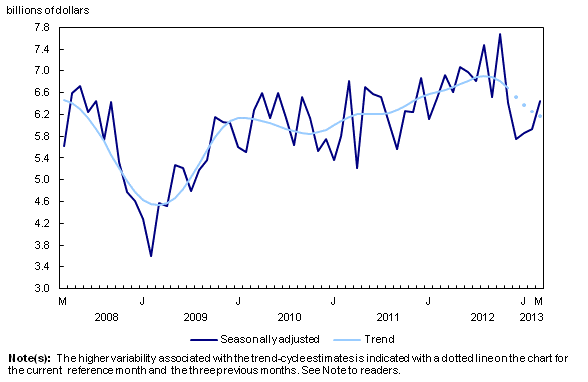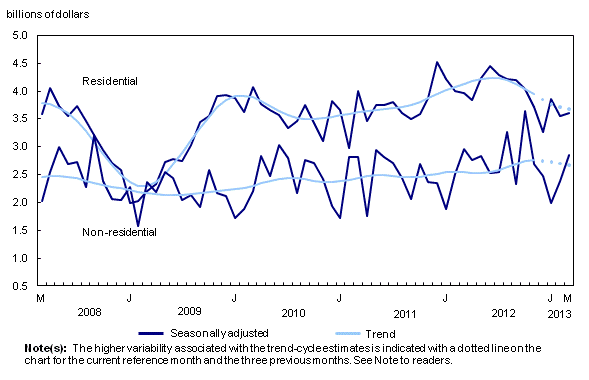Building permits, March 2013
Archived Content
Information identified as archived is provided for reference, research or recordkeeping purposes. It is not subject to the Government of Canada Web Standards and has not been altered or updated since it was archived. Please "contact us" to request a format other than those available.
Released: 2013-05-06
Contractors took out building permits worth $6.5 billion in March, up 8.6% from February and the third consecutive monthly advance. The March increase came mostly from the non-residential sector in Ontario and Alberta.
The advance in March was not sufficiently large to reverse the declining trend that began in the fall of 2012.
The value of non-residential building permits rose 19.0% to $2.8 billion, a second consecutive monthly gain. Ontario and Alberta were behind most of the growth at the national level. Declines were recorded in four provinces, with Quebec and Manitoba posting the largest decreases.
In the residential sector, the value of permits increased 1.7% to $3.6 billion. The advance came in the wake of an 8.1% decline in February. Despite this growth, residential construction intentions remained on a downward trend that started in mid-2012. The increase in March was attributable to building permits for multi-family dwellings. The value of residential buildings permits was up in seven provinces, led by Alberta. Quebec posted the largest decline.
Non-residential sector: Significant rise in the institutional component
In the institutional component, the value of permits more than doubled to $980 million in March, following a 28.1% increase in February. This was the highest level since October 2012, when the value of permits exceeded the $1-billion mark.
Institutional construction intentions were up in six provinces, with the largest increases in construction permits for government buildings in Alberta as well as medical and educational buildings in Ontario.
In the industrial component, the value of permits rose 17.2% to $472 million, a second consecutive monthly increase. This advance was the result of higher construction intentions for manufacturing plants in Ontario, British Columbia and Quebec, and for primary industry buildings in Saskatchewan, Ontario and Quebec. Gains were posted in seven provinces.
Following a 14.4% advance in February, Canadian municipalities issued $1.4 billion worth of commercial building permits in March, down 9.6%. The decline came from a variety of buildings, including recreational facilities, hotels and retail stores. Decreases occurred in six provinces, with Alberta posting the largest decline. In contrast, Ontario posted the largest gain, as a result of higher construction intentions for hotels, office buildings and warehouses.
Residential sector: Higher construction intentions for multi-family dwellings
The value of permits for multi-family dwellings rose 13.4% to $1.4 billion, following a 20.5% decrease the previous month. This increase more than offset the decline in the value of permits for single-family units. The growth was largely the result of major condominium apartment projects in Alberta. Gains were observed in all provinces except Quebec and Prince Edward Island.
Construction intentions for single-family dwellings fell 4.7% to $2.2 billion. The decline came in the wake of two consecutive monthly increases and was the fourth decrease in six months. Declines were registered in six provinces, with Ontario, Alberta and Manitoba accounting for most of the decrease.
Canadian municipalities approved the construction of 14,558 new dwellings, 4.3% more than in February. The advance was attributable to multi-family dwellings, which increased 11.8% to 8,321 units. In contrast, single-family dwellings declined 4.3% to 6,237 units.
Provinces: Large gains in Ontario and Alberta
In March, the value of permits was up in six provinces, led by Ontario and Alberta.
Ontario posted the largest gain, as a result of higher construction intentions for institutional and commercial buildings and, to a lesser extent, industrial buildings. In Alberta, institutional buildings and multi-family dwellings were behind the increase.
Saskatchewan followed a distant third, because of higher construction intentions for multi-family dwellings as well as institutional and industrial buildings.
Quebec posted the largest decline, as a result of lower construction intentions for multi-family dwellings, commercial structures and institutional buildings. In Manitoba, all components except multi-family dwellings contributed to the decline.
Significant increases in construction intentions in Toronto and Edmonton
In March, the total value of permits was up in 16 of the 34 census metropolitan areas.
The largest increases were in Toronto and Edmonton, with Saskatoon a distant third. In Toronto, the advance was largely attributable to commercial and institutional buildings. In Edmonton, the increase was primarily the result of higher construction intentions for institutional buildings. In Saskatoon, the value of permits was up for the third consecutive month in March, mostly because of institutional and industrial buildings.
In constrast, Montréal and Vancouver had the largest declines. In Montréal, construction intentions were down 17.8%, falling below the $500 million mark for the first time since November 2011. All components except the commercial component contributed to the decline. In Vancouver, commercial and institutional buildings and single-family dwellings were responsible for the decline.
Note to readers
Unless otherwise stated, this release presents seasonally adjusted data, which facilitates comparisons by removing the effects of seasonal variations. For more information on seasonal adjustment, see Seasonal adjustment and identifying economic trends.
The Building Permits Survey covers 2,400 municipalities representing 95% of the population. It provides an early indication of building activity.
The communities representing the other 5% of the population are very small, and their levels of building activity have little impact on the total for the entire population.
The value of planned construction activities shown in this release excludes engineering projects (for example, waterworks, sewers or culverts) and land.
For the purpose of this release, the census metropolitan area of Ottawa–Gatineau (Ontario/Quebec) is divided into two areas: Gatineau part and Ottawa part.
Revision
Data for the current reference month are subject to revision based on late responses. Data have been revised for the previous month.
The trend-cycle estimates have been added to the charts as a complement to the seasonally adjusted series. Both the seasonally adjusted and the trend-cycle estimates are subject to revision as additional observations become available. These revisions could be large and even lead to a reversal of movement, especially at the end of the series. The higher variability associated with the trend-cycle estimates is indicated with a dotted line on the chart.
The March 2013 issue of Building Permits (Catalogue number64-001-X) will soon be available.
Building permits data for April will be released on June 5.
Contact information
For more information, contact us (toll-free 1-800-263-1136; infostats@statcan.gc.ca).
To enquire about the concepts, methods or data quality of this release, contact Mariane Nozière Bien-Aimé (613-951-7520), Investment, Science and Technology Division.
- Date modified:



